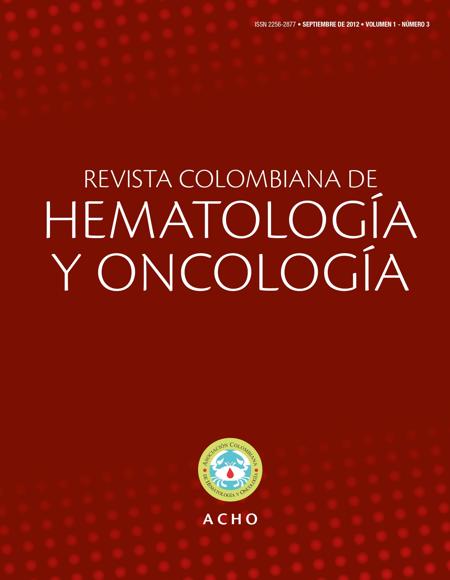Acquired haemophilia A : case report and literature review.
Hemofilia A adquirida : reporte de un caso y revisión de la literatura.

How to Cite
Download Citation

This work is licensed under a Creative Commons Attribution-NonCommercial-ShareAlike 4.0 International License.
Show authors biography
Acquired haemophilia A (AHA) is a very rare autoimmune disease characterized by presence of autoantibodies to circulating factor VIII; it manifests clinically as a hemorrhagic syndrome, especially with mucocutaneous, subcutaneous and soft tissues bleeding. Etiology is idiopathic in most cases; the other possible etiologies include collagen diseases, solid tumors, postpartum, hematolymphoid malignancies and drugs. Mortality depends on age, being majority of deaths in elderly people. We described a 93-years-old women presenting with a severe subcutaneous bleeding showing a prolonged partial thromboplastin time. In the diagnostic approach we found a diminished factor VIII-activity and high inhibitor titer (120 Bethesda units/ml) without a previous history of coagulation disorders. We initiated treatment with corticosteroids and then we added cyclophosphamide to achieve a reduction in the inhibitor titers and short the aPTT, however, patient died after three weeks due to an ischemic stroke unrelated to the prescribed treatment.
Article visits 601 | PDF visits 496
Downloads
- Knoebl P, Marco P, Baudo F, Collins P, Huth-Kühne A, Nemes L, et al. Demographic and clinical data in acquired hemophilia A: results from the European Acquired Haemophilia Registry (EACH2). J Thromb Haemost. 2012;10(4):622-31.
- Keeling D, Mackie I, Moore GW, Greer IA, Greaves M, British Committee for Standards in Haematology. Guidelines on the investigation and management of antiphospholipid syndrome. Br J Haematol. 2012 Feb 8. doi: 10.1111/j.1365- 2141.2012.09037.x. [Epub ahead of print].
- Webert KE. Acquired Hemophilia A. Semin Thromb Hemost. 2012 Sep 1. [Epub ahead of print].
- Franchini M, Gandini G, Di Paolantonio T, Mariani G. Acquired hemophilia A: a concise review. Am J Hematol. 2005;80(1):55-63.
- Ma AD, Carrizosa D. Acquired factor VIII inhibitors: pathophysiology and treatment. Hematology Am Soc Hematol Educ Program. 2006:432-7.
- Collins PW. Management of acquired haemophilia A. J Thromb Haemost. 2011;9 Suppl 1:226-35.
- Tufano A, Coppola A, Guida A, Cimino E, De Gregorio AM, Cerbone AM, et al. Acquired haemophilia a in the elderly: case reports. Curr Gerontol Geriatr Res. 2010;2010:927503.
- Sossa C, Jiménez S. Inhibidores contra los factores de la coagulación adquiridos espontáneamente: hemofilia B adquirida. Medunab. 2003;6(16):36-8.
- Huth-Kühne A, Baudo F, Collins P, Ingerslev J, Kessler CM, Lévesque H, et al. International recommendations on the diagnosis and treatment of patients with acquired hemophilia A. Haematologica. 2009;94(4):566-75.
- Tengborn L, Baudo F, Huth-Kühne A, Knoebl P, Lévesque H, Marco P, et al. Pregnancy-associated acquired haemophilia A: results from the European Acquired Haemophilia (EACH2) registry. BJOG. 2012 Aug 20. doi: 10.1111/j.1471-0528.2012.03469.x. [Epub ahead of print].
- Franchini M. Postpartum acquired factor VIII inhibitors. Am J Hematol. 2006;81(10):768-73.
- Baudo F, Caimi T, de Cataldo F. Diagnosis and treatment of acquired haemophilia. Haemophilia. 2010;16(102):102-6.
- Collins P, Baudo F, Huth-Kühne A, Ingerslev J, Kessler CM, Castellano ME, et al. Consensus recommendations for the diagnosis and treatment of acquired hemophilia A. BMC Res Notes. 2010;3:161.
- Baudo F, Collins P, Huth-Kühne A, Lévesque H, Marco P, Nemes L, et al. Management of bleeding in acquired hemophilia A: results from the European Acquired Haemophilia (EACH2) Registry. Blood. 2012;120(1):39-46.
- Delgado J, Jimenez-Yuste V, Hernandez-Navarro F, Villar A. Acquired haemophilia: review and meta-analysis focused on therapy and prognostic factors. Br J Haematol. 2003;121(1):21-35.
- Coppola A, Favaloro EJ, Tufano A, Di Minno MN, Cerbone AM, Franchini M. Acquired inhibitors of coagulation factors: part I-acquired hemophilia A. Semin Thromb Hemost. 2012;38(5):433-46.
- Aouba A, Rey G, Pavillon G, Jougla E, Rothschild C, Torchet MF, et al. Deaths associated with acquired haemophilia in France from 2000 to 2009: multiple cause analysis for best care strategies. Haemophilia. 2012;18(3):339-44.
- Franchini M, Targher G, Montagnana M, Lippi G. Laboratory, clinical and therapeutic aspects of acquired hemophilia A. Clin Chim Acta. 2008;395(1-2):14-8.
- Kitchen S, McCraw A. Diagnóstico de la hemofilia y otros trastornos de la coagulación: manual de laboratorio. 2a ed. Montreal: Federación Mundial de Hemofilia; 2010.
- Bowyer A, Smith J, Woolley AM, Kitchen S, Hampton KK, Maclean RM, et al. The investigation of a prolonged APTT with specific clotting factor assays is unnecessary if an APTT with Actin FS is normal. Int J Lab Hematol. 2011;33(2):212-8.
- Field JJ, Fenske TS, Blinder MA. Rituximab for the treatment of patients with very high-titre acquired factor VIII inhibitors refractory to conventional chemotherapy. Haemophilia. 2007;13(1):46-50.
- Collins PW, Percy CL. Advances in the understanding of acquired haemophilia A: implications for clinical practice. Br J Haematol. 2010;148(2):183-94.
- Collins PW, Hirsch S, Baglin TP, Dolan G, Hanley J, Makris M, et al. Acquired hemophilia A in the United Kingdom: a 2-year national surveillance study by the United Kingdom Haemophilia Centre Doctors’ Organisation. Blood. 2007;109(5):1870-7.
- Hoffman M, Dargaud Y. Mechanisms and monitoring of bypassing agent therapy. J Thromb Haemost. 2012;10(8):1478-85.
- Hay CR, Negrier C, Ludlam CA. The treatment of bleeding in acquired haemophilia with recombinant factor VIIa: a multicentre study. Thromb Haemost. 1997;78(6):1463-7.
- Baudo F, de Cataldo F, Gaidano G; Italian registry of acquired hemophilia. Treatment of acquired factor VIII inhibitor with recombinant activated factor VIIa: data from the Italian registry of acquired hemophilia. Haematologica. 2004;89(6):759-61.
- Sumner MJ, Geldziler BD, Pedersen M, Seremetis S. Treatment of acquired haemophilia with recombinant activated FVII: a critical appraisal. Haemophilia. 2007;13(5):451-61.
- Abshire T, Kenet G. Recombinant factor VIIa: review of efficacy, dosing regimens and safety in patients with congenital and acquired factor VIII or IX inhibitors. J Thromb Haemost. 2004;2(6):899-909.
- Cromwell C, Aledort LM. FEIBA: a prohemostatic agent. Semin Thromb Hemost. 2012;38(3):265-7.
- Holme PA, Brosstad F, Tjonnfjord GE. Acquired haemophilia: management of bleeds and immune therapy to eradicate autoantibodies. Haemophilia. 2005;11(5):510-5.
- Holmström M, Tran HT, Holme PA. Combined treatment with APCC (FEIBA®) and tranexamic acid in patients with haemophilia A with inhibitors and in patients with acquired haemophilia A--a two-centre experience. Haemophilia. 2012;18(4):544-9.
- Kasper CK. Human factor VIII for bleeding in patients with inhibitors. Vox Sang. 1999;77 Suppl 1:47-8.
- Morrison AE, Ludlam CA, Kessler C. Use of porcine factor VIII in the treatment of patients with acquired hemophilia. Blood. 1993;81(6):1513-20.
- Franchini M, Lippi G. The use of desmopressin in acquired haemophilia A: a systematic review. Blood Transfus. 2011;9(4):377-82.
- Hay CR, Brown S, Collins PW, Keeling DM, Liesner R. The diagnosis and management of factor VIII and IX inhibitors: a guideline from the United Kingdom Haemophilia Centre Doctors Organisation. Br J Haematol. 2006;133(6):591-605.
- Green D, Rademaker AW, Briët E. A prospective, randomized trial of prednisone and cyclophosphamide in the treatment of patients with factor VIII autoantibodies. Thromb Haemost. 1993;70(5):753-7.
- Collins P, Baudo F, Knoebl P, Lévesque H, Nemes L, Pellegrini F, et al. Immunosuppression for acquired hemophilia A: results from the European Acquired Haemophilia Registry (EACH2). Blood. 2012;120(1):47-55.
- Crenier L, Ducobu J, des Grottes JM, Cerny J, Delaunoit C, Capel P. Low response to high-dose intravenous immunoglobulin in the treatment of acquired factor VIII inhibitor. Br J Haematol. 1996;95(4):750-3.
- Boles JC, Key NS, Kasthuri R, Ma AD. Single-center experience with rituximab as first-line immunosuppression for acquired hemophilia. J Thromb Haemost. 2011;9(7):1429-31.
- Pardos-Gea J, Altisent C, Parra R, Vilardell-Tarres M, Ordi-Ros J. Acquired haemophilia A. First line treatment with calcineurin inhibitors and steroid pulses: a 10-year follow-up study. Haemophilia. 2012;18(5):789-93.
- Lian EC, Villar MJ, Noy LI, Ruiz-Dayao Z. Acquired factor VIII inhibitor treated with cyclophosphamide, vincristine, and prednisone. Am J Hematol. 2002;69(4):294-5.
- Green D, Lechner K. A survey of 215 non-hemophilic patients with inhibitors to Factor VIII. Thromb Haemost. 1981;45(3):200-3.
- Katgi A, Ataca P, Kahraman S, Piskin O, Ozcan MA, Demirkan F, et al. Ischemic stroke after recombinant factor VIIa treatment in acquired hemophilia A patient. Blood Coagul Fibrinolysis. 2012;23(1):69-70.
- O’Connell KA, Wood JJ, Wise RP, Lozier JN, Braun MM. Thromboembolic adverse events after use of recombinant human coagulation factor VIIa. JAMA. 2006;295(3):293-8.

















